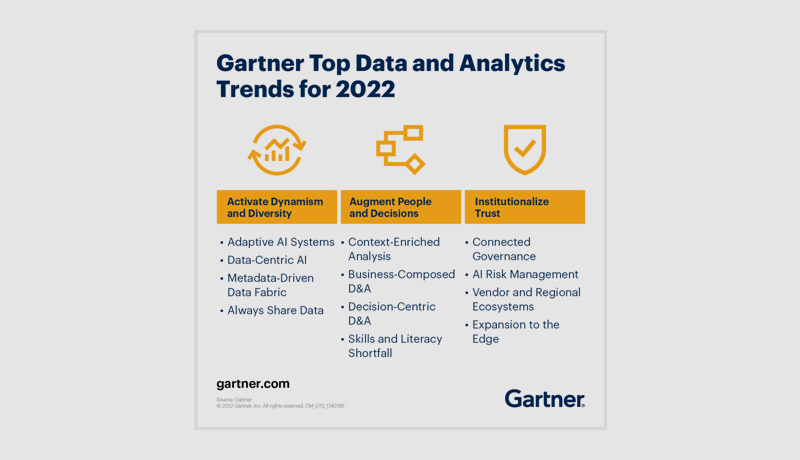
Adaptive artificial intelligence (AI) systems, data sharing and data fabrics are among the trends that data and analytics leaders need to build on to drive new growth, resilience and innovation, says Rita Sallam, Distinguished VP Analyst at Gartner
Russia’s invasion of Ukraine added a geopolitical crisis to the enduring global pandemic, and managing consequent and persistent uncertainty and volatility will be a key focus for data and analytics leaders this year.
“Now is the time to anticipate, adapt and scale the value of your D&A strategy by monitoring, experimenting with or aggressively investing in key D&A technology trends based on their urgency and alignment to business priorities,” says Rita Sallam, Distinguished VP Analyst at Gartner.
This year’s top trends in data and analytics relate to three imperatives:

We’ve identified the data and analytics trends that represent business, market and technology dynamics that you cannot afford to ignore. These trends also help prioritize investments to drive new growth, efficiency, resilience and innovation.
As decisions become more connected, contextual and continuous, it’s increasingly important to reengineer decision making. You can do so by using adaptive AI systems, which can offer faster and flexible decisions by adapting more quickly to changes.
However, to build and manage adaptive AI systems, adopt AI engineering practices. AI engineering orchestrates and optimizes applications to adapt to, resist or absorb disruptions, facilitating the management of adaptive systems.
Many organizations attempt to tackle AI without considering AI-specific data management issues. “Without the right data, building AI is risky and possibly dangerous,” says Sallam. As such, it is critical to formalize data-centric AI and AI-centric data. They address data bias, diversity and labeling in a more systematic way as part of your data management strategy — including, for example, using data fabric in automated data integration and active metadata management.
The data fabric listens, learns and acts on the metadata. It flags and recommends actions for people and systems. Ultimately, it improves trust in, and use of, data in the organization and can reduce by 70% various data management tasks, including design, deployment and operations.
As an example, the city of Turku in Finland foundgaps in its data held back its innovation. By integrating fragmented data assets, it was able to reuse data, reduce time to market by two-thirds and create a monetizable data fabric.
While data and analytics leaders often acknowledge that data sharing is a key digital transformation capability, they lack the know-how to share data at scale and with trust.
To succeed in promoting data sharing and increasing access to the right data aligned to the business case, collaborate across business and industry lines. This will accelerate buy-in for increased budget authority and investment in data sharing. In addition, consider adopting data fabric design to enable a single architecture for data sharing across heterogeneous internal and external data sources.
Context-enriched analysis builds on graph technologies. The information on the user’s context and needs is held in a graph that enables deeper analysis using the relationships between data points as much as the data points themselves. It helps identify and create further context based on similarities, constraints, paths and communities.
Capturing, storing and using contextual data demands capabilities and skills in building data pipelines, X analytics techniques and AI cloud services that can process different data types. By 2025, context-driven analytics and AI models will replace 60% of existing models built on traditional data.
Gartner champions a modular approach to data and analytics, or “composable D&A.” Business-composed data and analytics builds on this trend, but the focus is on the people side, shifting from IT to business.
Business-composed D&A enables the business users or business technologists to collaboratively craft business-driven data and analytics capabilities.
The discipline of decision intelligence, which is careful consideration of how decisions should be made, is causing organizations to rethink their investments in D&A capabilities. Use decision intelligence disciplines to design the best decision, and then deliver the required inputs.
Gartner estimates that by 2023, more than 33% of large organizations will have analysts practicing decision intelligence, including decision modeling.
D&A leaders need talent on their team to drive measurable outcomes. However, virtual workplaces and the heightened competition for talent have increased the lack of data literacy — the ability to read, write and communicate data in context — within the workforce.
Through 2025, Gartner estimates that the majority of CDOs will faiI to foster the necessary data literacy within the workforce to achieve their stated strategic data-driven business goals.
As the cost of investing in data literacy and employee upskilling is constantly rising, start inserting “claw-back” or “payback” clauses into contracts with new hires to recover costs in the event that an employee departs your organization.
Organizations need effective governance at all levels that not only addresses their existing operational challenges, but is also flexible, scalable and highly responsive to changing market dynamics and strategic organizational challenges.
However, the pandemic has further highlighted the urgent need for strong cross-functional collaboration and readiness to change organizational structures to achieve business model agility.
Use connected governance to establish a virtual D&A governance layer across business functions and geographies to achieve desired cross-enterprise business outcomes.
If organizations spend time and resources on supporting AI trust, risk and security management (TRiSM), they will see improved AI outcomes in terms of adoption, achieved business goals and both internal and external user acceptance.
Gartner predicts that by 2026, organizations that develop trustworthy, purpose-driven AI will see over 75% of AI innovations succeed, compared to 40% among those that don’t.
Increased focus on AI TRiSM will lead to controlled and stable implementation and operationalization of AI models. In addition, Gartner expects far fewer AI failures, including incomplete AI projects, and a reduction in unintended or negative outcomes.
Regional data security laws are making many global organizations build regional D&A ecosystems to comply with local regulation. This trend will accelerate in the new multipolar world.
You will need to consider migrating and duplicating some or all parts of your D&A stack within specific regions, and by design or by default, manage a multicloud and multivendor strategy.
To build a cohesive cloud data ecosystem, consider several actions. Evaluate the extensibility and broader ecosystem offerings of your vendor’s solutions and consider aligning with them. Also, reevaluate the policies favoring a best-of-breed or best-fit strategy for end-to-end D&A capabilities in the cloud by weighing the benefits of a single vendor ecosystem in terms of cost, agility and speed.
More D&A activities are executed in distributed devices, servers or gateways located outside data centers and public cloud infrastructure. They increasingly reside in edge computing environments, closer to where the data and decisions of interest are created and executed.
Gartner analysts estimate that by 2025, more than 50% of enterprise-critical data will be created and processed outside the data center or cloud.
Extend D&A governance capabilities to edge environments and provide visibility through active metadata. In addition, provide support for data persistence in edge environments by including edge-resident IT-oriented technologies (relational and nonrelational database management systems), as well as small-footprint embedded databases for the storage and processing of data closer to the device edge.
